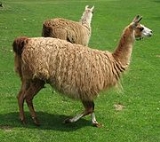
Tylopoda
Encyclopedia
Tylopoda is a suborder of terrestrial
herbivorous even-toed ungulate
s belonging to Artiodactyla. They are extant in the wild in their native ranges of South America
and Asia
, while Australian feral camel
s are an introduced species
. The group has a long fossil history in North America
and Europe
. Tylopoda appeared during the Eocene
around 46.2 million years ago.
Tylopoda has only one extant family, Camelidae, which includes camels, llamas, guanacos
, alpacas and vicuñas. This group was much more diverse in the past, containing the now extinct families Xiphodontidae
, Oromerycidae
and Cainotheriidae, as well as the two families of oreodonts, Agriochoeridae and Merycoidodontidae.
by Matthew (1908); to Artiodactyla by Flower (1883) and Carroll (1988); to Neoselenodontia by Whistler and Webb (2005); and to Cetartiodactyla
by Ursing et al. (2000) and Agnarsson and May-Collado (2008).
Terrestrial animal
Terrestrial animals are animals that live predominantly or entirely on land , as compared with aquatic animals, which live predominantly or entirely in the water , or amphibians, which rely on a combination of aquatic and terrestrial habitats...
herbivorous even-toed ungulate
Even-toed ungulate
The even-toed ungulates are ungulates whose weight is borne about equally by the third and fourth toes, rather than mostly or entirely by the third as in odd-toed ungulates such as horses....
s belonging to Artiodactyla. They are extant in the wild in their native ranges of South America
South America
South America is a continent situated in the Western Hemisphere, mostly in the Southern Hemisphere, with a relatively small portion in the Northern Hemisphere. The continent is also considered a subcontinent of the Americas. It is bordered on the west by the Pacific Ocean and on the north and east...
and Asia
Asia
Asia is the world's largest and most populous continent, located primarily in the eastern and northern hemispheres. It covers 8.7% of the Earth's total surface area and with approximately 3.879 billion people, it hosts 60% of the world's current human population...
, while Australian feral camel
Australian feral camel
Thousands of the two main species of Australian feral camels, mostly dromedaries but also some bactrian camels, were imported into Australia during the 19th century for transport and construction as part of the colonisation of the central and western parts of Australia. Motorised transport replaced...
s are an introduced species
Introduced species
An introduced species — or neozoon, alien, exotic, non-indigenous, or non-native species, or simply an introduction, is a species living outside its indigenous or native distributional range, and has arrived in an ecosystem or plant community by human activity, either deliberate or accidental...
. The group has a long fossil history in North America
North America
North America is a continent wholly within the Northern Hemisphere and almost wholly within the Western Hemisphere. It is also considered a northern subcontinent of the Americas...
and Europe
Europe
Europe is, by convention, one of the world's seven continents. Comprising the westernmost peninsula of Eurasia, Europe is generally 'divided' from Asia to its east by the watershed divides of the Ural and Caucasus Mountains, the Ural River, the Caspian and Black Seas, and the waterways connecting...
. Tylopoda appeared during the Eocene
Eocene
The Eocene Epoch, lasting from about 56 to 34 million years ago , is a major division of the geologic timescale and the second epoch of the Paleogene Period in the Cenozoic Era. The Eocene spans the time from the end of the Palaeocene Epoch to the beginning of the Oligocene Epoch. The start of the...
around 46.2 million years ago.
Tylopoda has only one extant family, Camelidae, which includes camels, llamas, guanacos
Guañacos
Guañacos is a village and municipality in Neuquén Province in southwestern Argentina.-References:...
, alpacas and vicuñas. This group was much more diverse in the past, containing the now extinct families Xiphodontidae
Xiphodontidae
Xiphodontidae is an extinct family of even-toed ungulates , endemic to Europe during the Eocene 40.4—33.9 Ma, existing for approximately .. They were, most likely, all terrestrial herbivores.-Taxonomy:...
, Oromerycidae
Oromerycidae
Oromerycidae is a small extinct family of artiodactyls closely related to living camels, known from the middle to late Eocene of western North America....
and Cainotheriidae, as well as the two families of oreodonts, Agriochoeridae and Merycoidodontidae.
Taxonomy
Tylopoda was named by Illiger (1811). It is extant. It was considered monophyletic by Matthew (1908). It was reranked as the unranked clade Tylopoda by Matthew (1908); it was reranked as the suborder Tylopoda by Carroll (1988), Ursing et al. (2000) and Whistler and Webb (2005). It was assigned to RuminantiaRuminantia
Ruminantia includes many of the well-known large grazing or browsing mammals: among them cattle, goats, sheep, deer, and antelope. All members of the Ruminantia are ruminants: they digest food in two steps, chewing and swallowing in the normal way to begin with, and then regurgitating the...
by Matthew (1908); to Artiodactyla by Flower (1883) and Carroll (1988); to Neoselenodontia by Whistler and Webb (2005); and to Cetartiodactyla
Cetartiodactyla
Cetartiodactyla is the clade in which whales and even-toed ungulates have currently been placed. The term was coined by merging the name for the two orders, Cetacea and Artiodactyla, into a single word. The term Cetartiodactyla reflects the idea that whales evolved within the artiodactyls...
by Ursing et al. (2000) and Agnarsson and May-Collado (2008).

